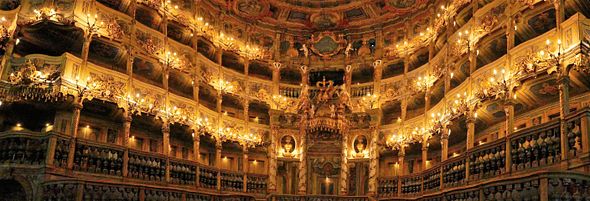
Let's start with a Lehndorff diary entry. When Wilhelmine was alive, he was at times critical of her (too much Fritz praise, something of a snob, make-up, likes books better than most people), but did admire her intelligence and thought she should have been a Queen. Otoh, by the time he visited Bayreuth for the first time, in June 1782 - when not only Wilhelmine but also her husband and daughter were dead, and Bayreuth had been taken over by the Ansbach in-laws -, he was in a much more mellow mood about her, and full of admiration for what she had created, and wrote:
„From there, I visit the Eremitage, about an hour away from Bayreuth. This is a beautiful palace. I have never seen anything which has caused me as much pleasure to watch. It shows an exquisite, incomparable sense of art. The spirit of the late Margravine, the older sister of my King, can be found everywhere. Especially beautiful to me is the grave of Vergil which the Margravine has had copied exactly as she herself as seen it. There is a grotto theatre here which is unique for its kind. In order to get to the palace, one has to cross the Parnassuss, the mountain of the Muses. I spend four hours in this wonderful place. Sadness fills me as I have to leave it, and have to tell me that so much beauty no longer finds any attention since the serene lady who has created it has gone. Oh vanity of vanities!
The new palace with its grotto and shell decoration in blue and white looks like it has escaped a fairy tale. Further, I visit the new Bayreuth promenade, which has been built under the supervision of Baron Seckendorff, who is the current first minister. I visit the opera house as well. Everything shows its builder’s wonderful taste. But all is dead! It is this which fills me with sadness.I hear you, Lehndorff. Let's start with the tombs of Wilhelmine, her husband and her daughter, in the former palace church, the
Schlosskirche. Now, Bayreuth was Lutheran-Protestant. But due to all the Italians and some of the French the various Margraves, especially Wilhelmine, hired, there grew to be a sizable Catholic minority in Bayreuth. By 1813, they were given the Schlosskirche to use. Decades later, the requiem for Franz Liszt the composer and pianist (who died in Bayreuth) was celebrated there. This as explanation why three Calvinists are buried in a cheerfully glittery Catholic church. With a Voltaire quote, in Wilhelmine's case.
( Check it all out beneath the cut )Wilhelmine's greatest contribution to Bayreuth the city remains the opera house, which has been classified as a World Heritage object by UNESCO in 2012. It was inaugurated on the occasion of her daughter's wedding, built within two years (which given the end result is amazingly short), and it's completely preserved in its original form. (Except for the curtain whom Napoleon's troops confiscated en route to Moscow in 1812.) Now, Wilhelmine had started to collect an ensemble of musicians and singers through the 1730s already and produced operas then, too, but there hadn't been a separate opera building until the wedding in 1748. It was used often until Wilhelmine's death, less often but still in the immediate years after, but after her widower had died (five years after Willhelmine) and Bayreuth was inherited by ghastly Uncle Christian, there were no more operas for years. By the time there was again a ruler with musical linterests, opera fashion had changed, big time, and the opera house was rarely used anymore, which is undoubtedly why it's so well preserved. It was the original reason why Richard Wagner came to Bayreuth. (The stage has a depth of 27 metres, which sounded great to
Ring of the Nibelungs composing Wagner), but on second thought, he realised the Rokoko surroundings would clash with the
Ring in a major fashion and got King Ludwig II to finance a new building instead. (Though he did produce both
Tannhäuser and
Lohengrin in this building before his own was finished.) These days, after the Wagner festival is over the one in Wilhelmine's opera house starts. (Well, in normal times it does.) Parts of the movie
Farinelli were filmed here. The architects were Giuseppe und Carlo Galli da Bibiena who were inspired partly by the
Hofburg in Vienna (!), and partly by Dresden, but had the ingenious and money saving idea to do it all in wood and painting.
( Behold the Baroque/Rokoko opera house to end them all )Off to the "Hermitage" - the
Eremitage, the countryside residence of the Margraves near Bayreuth. Though Wilhelmine didn't start it, she added the most famous contributions. The original builder was Margrave Georg Wilhelm. We haven't met him before, since he died in 1726, thereby making Wilhelmine's future father-in-law Margrave. Georg Wilhelm had good musical taste (he was Telemann's patron and produced no less than fifty operas in German (!), and loved to build, and these are the only good things you can say about him. He married 15 years old teenager and was ravingly jealous, so he locked her up at the Plassenburg (this was clearly the era for this). His only surviving daughter (no sons survived, which is why Bayreuth was inherited by Wilhelmine's father-in-law) produced illegitimate twins, whereupon she was locked up as well. And he ordered fifteen Sinti women hanged when they didn't leave the country after he ordered them. So: you wouldn't want to meet him. However, left some nice landscapes. To quote the official Eremitage website:
n 1715 Margrave Georg Wilhelm (reigned 1712-26) began extending the deer park laid out in 1664 to create a Hermitage, with a summer palace as the focal point. The four-winged complex by Johann David Räntz was originally surrounded on three sides by rows of linden trees which met overhead to form an enclosed corridor. In front of the Festival Hall was a parterre, followed by a cascade which ran down to the Red Main river.
Paths led across the wooded north slope to scattered huts built as retreats for the "hermits". The palace drive terminates at an artificial hill, the Parnassus and a pergola turning off at right angles to the drive leads on to the palace. The Hermitage was conceived by Margrave Georg Wilhelm as a setting where the margravial court could imitate the "simple life" of a hermit order.
( The Simple Life as imagined by Georg Wilhelm's architects: )Now, after Wilhelmine's husband became Margrave 1735, he presented her with this bit of real estate. Wilhelmine believed in thinking big and wasn't deterred by a Franconian budget. The website again:
The Old Palace was enlarged and a number of new garden areas were created with water and architectural features, such as the Lower Grotto and the Orangery (today the New Palace) with the Large Pond.
Wilhelmine used traditional elements of garden design such as boskets, pergolas and fountains for the enlarged park. With the free arrangement of the individual garden areas, the absence of a dominant, central axis and the independence of the various sections from one another she departed noticeably from baroque garden traditions. This, together with the artificial ruins, such as the Ruin Theatre and the Margrave's Hermitage, makes the Hermitage one of the most unusual gardens of the 18th century. Sadly, due to Covid, one can't visit the inside of the Old Palace these days, and the New Palace's inner rooms were a victim of a WW II bomb and subsequent fire. They're currently used for exhibitions of modern art. However, the outside was restored completely.
( Where Apollo resides (also, Wilhelmine could make the water fountain work) )Wandering through the park, you encounter fake ruins (same in Rheinsberg and Sanssouci).
( Folichon's tombstone and Voltaire's home away from home ).png?width=590&height=370&fit=bounds)
.png?width=590&height=370&fit=bounds)















